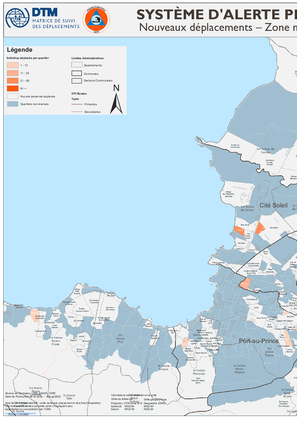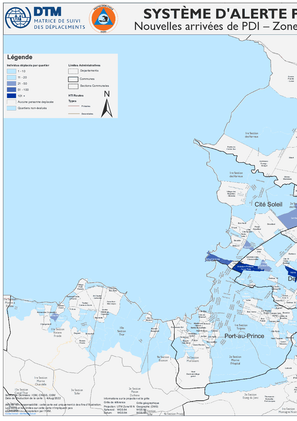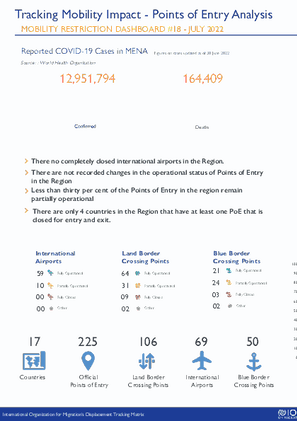-
Countries
-
Data and Analysis
-
Special Focus
-
Crisis Responses
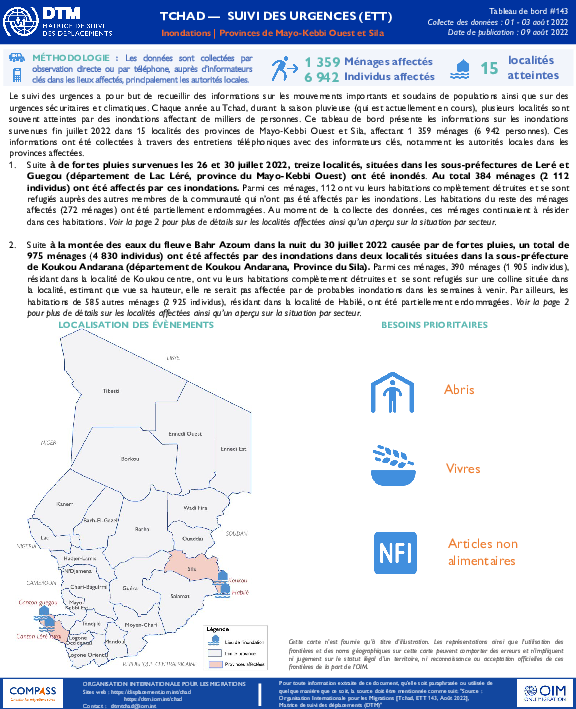
Contact
DTM Tchad, dtmtchad@iom.int
Language
French
Location
Chad
Period Covered
Jul 26 2022
Jul 30 2022
Activity
- Mobility Tracking
- Event Tracking
Le suivi des urgences a pour but de recueillir des informations sur les mouvements importants et soudains de populations ainsi que sur des urgences sécuritaires et climatiques. Chaque année au Tchad, durant la saison pluvieuse (qui est actuellement en cours), plusieurs localités sont souvent atteintes par des inondations affectant de milliers de personnes.
Ce tableau de bord présente les informations sur les inondations survenues fin juillet 2022 dans 15 localités des provinces de Mayo-Kebbi Ouest et Sila, affectant 1 359 ménages (6 942 personnes). Ces informations ont été collectées à travers des entretiens téléphoniques avec des informateurs clés, notamment les autorités locales dans les provinces affectées.
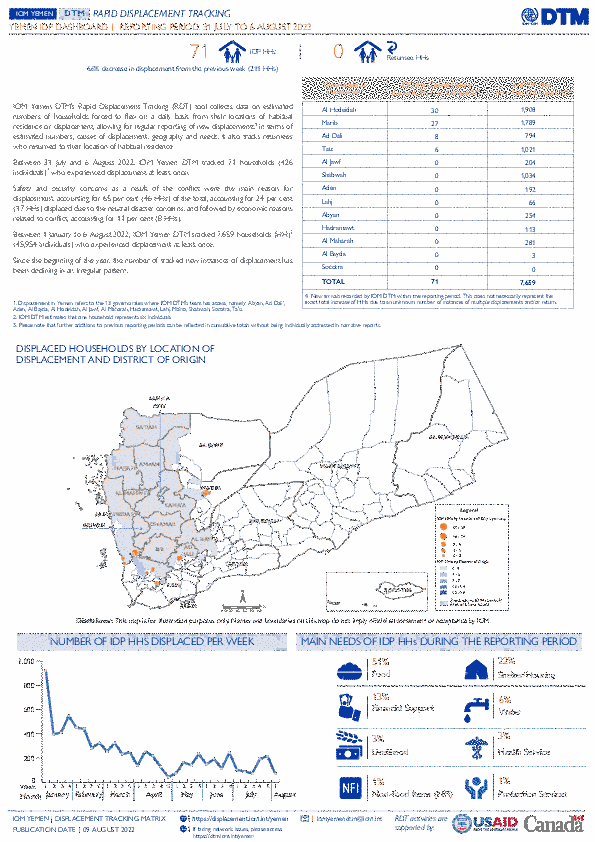
Contact
DTM Yemen, iomyemendtm@iom.int
Language
English
Location
Yemen
Period Covered
Jul 31 2022
Aug 06 2022
Activity
- Mobility Tracking
From 1 January to 6 August 2022, IOM Yemen DTM tracked 7,659 households (HH) (45,954 Individuals) who experienced displacement at least once.
Between 31 July and 6 August 2022, IOM Yemen DTM tracked 71 households (426 individuals) displaced at least once. The majority of people moved into/within the following governorates and districts:
- Al Hodeidah (30 HHs) – Hays (24 HHs), Al Khukhah (6 HHs) districts. Most displacements in the governorate were internal.
- Marib (27 HHs) – Marib City (24 HHs), Marib (3 HHs) districts. Most displacements in the governorate originated from Marib and Hajjah.
- Ad Dali (8 HHs) – Qatabah (7 HHs), Ad Dali (1 HH) districts. Most displacements in the governorate originated from Ad Dali and Taiz.
The majority of people moved from the following governorates and districts:
- Al Hodeidah (33 HHs) – Hays (24 HHs), Al Jarrahi (3 HHs), Al Hali (2 HHs) districts.
- Marib (17 HHs) – Marib City (15 HHs), Sirwah (1 HH), Raghwan (1 HH) districts.
- Taiz (7 HHs) – Maqbanah (5 HHs), Sabir Al Mawadim (1 HH), Al Mudhaffar (1 HH) districts.
Contact
DTM Yemen, iomyemendtm@iom.int
Location
Yemen
Activity
- Mobility Tracking
- Event Tracking
Period Covered
Jul 31 2022 -Aug 06 2022
From 1 January to 6 August 2022, IOM Yemen DTM tracked 7,659 households (HH) (45,954 Individuals) who experienced displacement at least once.
Between 31 July and 6 August 2022, IOM Yemen DTM tracked 71 households (426 individuals) displaced at least once. The majority of people moved into/within the following governorates and districts:
- Al Hodeidah (30 HHs) – Hays (24 HHs), Al Khukhah (6 HHs) districts. Most displacements in the governorate were internal.
- Marib (27 HHs) – Marib City (24 HHs), Marib (3 HHs) districts. Most displacements in the governorate originated from Marib and Hajjah.
- Ad Dali (8 HHs) – Qatabah (7 HHs), Ad Dali (1 HH) districts. Most displacements in the governorate originated from Ad Dali and Taiz.
- Al Hodeidah (33 HHs) – Hays (24 HHs), Al Jarrahi (3 HHs), Al Hali (2 HHs) districts.
- Marib (17 HHs) – Marib City (15 HHs), Sirwah (1 HH), Raghwan (1 HH) districts.
- Taiz (7 HHs) – Maqbanah (5 HHs), Sabir Al Mawadim (1 HH), Al Mudhaffar (1 HH) districts.
Population Groups
Survey Methodology
Unit of Analysis Or Observation
Type of Survey or Assessment
Keywords
Geographical Scope
Administrative boundaries with available data
The current dataset covers the following administrative boundaries
Contact
DTMUkraine@iom.int
Location
Ukraine
Activity
- Mobility Tracking
- Baseline Assessment
Period Covered
Jul 25 2022 -Aug 05 2022
A baseline assessment is a sub-component of mobility tracking. It aims to collect data on IDP, migrant or returnee population presence in a defined administrative area of the country.
Population Groups
Survey Methodology
Unit of Analysis Or Observation
Type of Survey or Assessment
Keywords
Geographical Scope
Administrative boundaries with available data
The current dataset covers the following administrative boundaries
Contact
DTMUkraine@iom.int
Location
Ukraine
Activity
- Mobility Tracking
- Baseline Assessment
Period Covered
Jul 25 2022 -Aug 05 2022
A baseline assessment is a sub-component of mobility tracking. It aims to collect data on IDP, migrant or returnee population presence in a defined administrative area of the country.
This is a restricted dataset. To get access, kindly click on the 'Request Access' button.
Population Groups
IDPs
Survey Methodology
Unit of Analysis Or Observation
Admin Area 2
Type of Survey or Assessment
Key Informant
Keywords
Geographical Scope Partial Coverage
Administrative boundaries with available data
The current dataset covers the following administrative boundaries
Carte des nouveaux déplacements – Zone métropolitaine de Port-au-Prince – 23 au 29 juillet 2022.
Carte des Nouvelles arrivées des PDI dans la zone métropolitaine de Port-au-Prince, du 23 au 29 juillet 2022
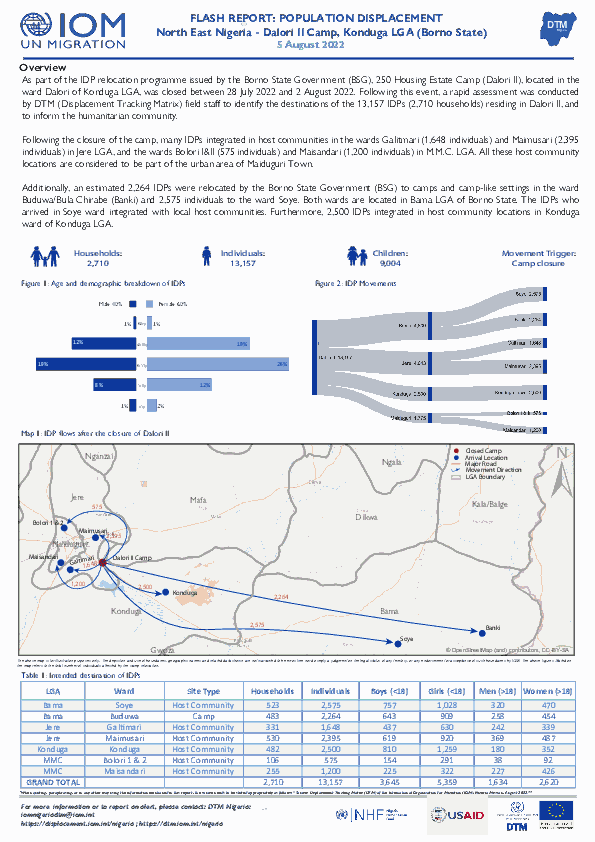
Contact
DTM Nigeria, AllUsersInDTMNigeria@iom.int
Language
English
Location
Nigeria
Period Covered
Jul 28 2022
Aug 02 2022
Activity
- Mobility Tracking
- Event Tracking
As part of the IDP relocation programme issued by the Borno State Government (BSG), 250 Housing Estate Camp (Dalori II), located in Dalori ward of Konduga LGA, was closed between 28 July 2022 and 2 August 2022. Following this event, a rapid assessment was conducted by DTM (Displacement Tracking Matrix) field staff to identify the destinations of the 13,157 IDPs (2,710 households) residing in Dalori II, and to inform the humanitarian community.
This Middle East and North Africa (MENA) report summarizes mobility restrictions at airports, land, and blue border crossing points resulting from the mitigation measures implemented in response to the COVID-19 pandemic.

Contact
DTM Sudan; dtmsudan@iom.int
Language
English
Location
Sudan
Snapshot Date
Jul 14 2022
Activity
- Mobility Tracking
- Event Tracking
The DTM Emergency Event Tracking (EET) is deployed to track sudden displacement and population movements, provide more frequent updates on the scale of displacement, and quantify the affected population when needed. As a subcomponent of the new Mobility Tracking methodology in Sudan (Round Four), and activated on a need basis, EET utilises a broad network of key informants to capture best estimates of the affected population presence per location – a useful tool for humanitarian response planning and design.
